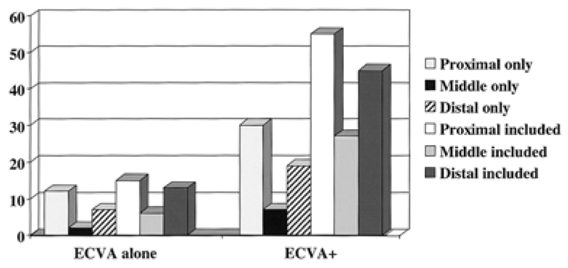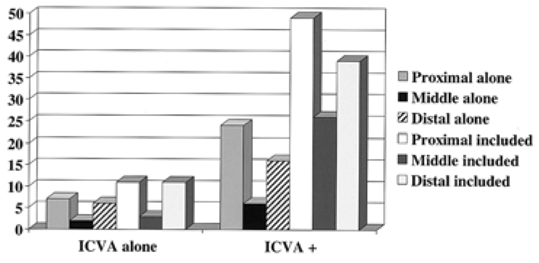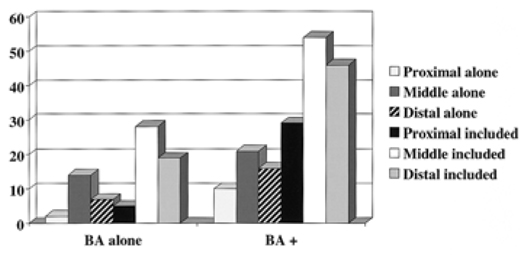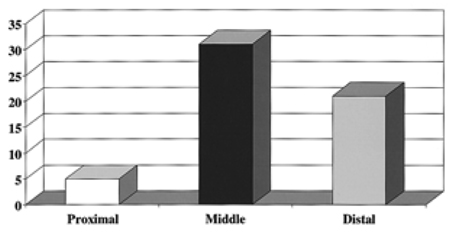J Clin Neurol.
2005 Apr;1(1):31-49. 10.3988/jcn.2005.1.1.31.
New England Medical Center Posterior Circulation Stroke Registry II. Vascular Lesions
- Affiliations
-
- 1Cerebrovascular Disease Sections of the New England Medical Center, Boston and the Beth Israel Deaconess Medical Center, Boston. lcaplan@bidmc.harvard.edu
- KMID: 2287712
- DOI: http://doi.org/10.3988/jcn.2005.1.1.31
Abstract
- Among 407 New England Medical Center Posterior Circulation Registry (NEMC-PCR) patients, the extracranial (ECVA) and intracranial vertebral arteries (ICVA) were the commonest sites of severe occlusive disease followed by the basilar artery (BA). Severe occlusive lesions were found in >1 large artery in 148 patients; 134 had unilateral or bilateral severe disease at one arterial location. Single arterial site occlusive disease occurred most often in the ECVA (52 patients, 15 bilateral) followed by the ICVA (40 patients, 12 bilateral) and the BA (46 patients). Involvement of the ICVAs and the BA was very common and some patients also had ECVA lesions. Hypertension, smoking, and coronary and peripheral vascular disease were most prevalent in patients with extracranial disease while diabetes and hyperlipidemia were more common when occlusive lesions were only intracranial. Intra-arterial embolism was the most common mechanism of brain infarction in patients with ECVA and ICVA occlusive disease. ICVA occlusive lesions infrequently caused infarction limited to the proximal territory (medulla and posterior inferior cerebellum). BA lesions most often caused infarcts limited to the middle posterior circulation territory (pons and anterior inferior cerebellum). Posterior cerebral artery occlusive lesions were predominantly embolic. Penetrating artery disease caused mostly pontine and thalamic infarcts. Prognosis was poorest in patients with BA disease. The best prognosis surprisingly was in patients who had multiple arterial occlusive lesions; they often had position-sensitive transient ischemic attacks during months or years.
Keyword
MeSH Terms
Figure
Reference
-
1. Fisher CM, Gore I, Okabe N, White PD. Calcification of the carotid siphon. Circulation. 1965. 32:538–548.
Article2. Hass WK, Fields WS, North RR, Kircheff II, Chase NE, Bauer RB. Joint study of extracranial arterial occlusions. 11 Arteriography, techniques, sites, and complications. JAMA. 1968. 203:961–968.
Article3. Caplan LR. Caplan's Stroke, a clinical approach. 2000. 3rd ed. Boston: ButterworthHeinemann.4. Solberg LA, McGarry P. Cerebral atherosclerosis in Negroes and Caucasians. Atherosclerosis. 1972. 16:141–154.
Article5. Gorelick PB, Caplan LR, Hier DB, Parker SL, Patel D. Racial differences in the distribution of anterior circulation occlusive disease. Neurology. 1984. 34:54–59.
Article6. Caplan LR, Gorelick PB, Hier DB. Race, sex, and occlusive cerebrovascular disease: a review. Stroke. 1986. 17:648–655.
Article7. Feldmann E, Daneault N, Kwan E, Ho KJ, Pessin MS, Langenberg P, Caplan LR. Chinese white differences in the distribution of occlusive cerebrovascular disease. Neurology. 1990. 40:1541–1545.8. Caplan LR. Intracranial branch atheromatous disease: a neglected, understudied and underused concept. Neurology. 1989. 39:1246–1250.
Article9. Bogousslavsky J, Van Melle G, Regli F. The Lausanne Stroke Registry: analysis of 1000 consecutive patients with first stroke. Stroke. 1988. 19:1083–1092.
Article10. Foulkes MA, Wolf PA, Price TR, Mohr JP, Hier DB. The Stroke Data Bank: design, methods, and baseline characteristics. Stroke. 1988. 19:547–554.
Article11. Mohr J, Caplan LR, Melski J, Duncan G, Goldstein R, Kistler JP, et al. The Harvard Cooperative Stroke Registry: a prospective registry. Neurology. 1978. 28:754–762.
Article12. Hennerici M, Aulich A, Sandmann W, Freund HJ. Incidence of asymptomatic extracranial arterial d.isease. Stroke. 1981. 12:750–758.
Article13. Caplan LR. Posterior circulation ischemia: then, now, and tomorrow. The Thomas Willis Lecture- 2000. Stroke. 2000. 31:2011–2023.
Article14. Caplan LR. Posterior circulation vascular disease: clinical features, diagnosis, and management. 1996. Boston: Blackwell.15. Caplan LR, Wityk RJ, Glass TA, et al. The New England Medical Center Posterior Circulation Registry. Ann Neurol. 2004. 56:389–398.16. Gorelick PB, Caplan LR, Hier DB, Patel D, Langenberg P, Pessin MS, et al. Racial differences in the distribution of posterior circulation occlusive disease. Stroke. 1985. 16:785–790.
Article17. Caplan LR, Tettenborn B. Vertebrobasilar occlusive disease: review of selected aspects. 1. spontaneous dissection of extracranial and intracranial posterior circulation arteries. Cerebrovasc Dis. 1992. 2:256–265.
Article18. Baker AB, lannone A. Cerebrovascular disease: 1. the large arteries of the circle of Willis. Neurology. 1959. 9:321–332.
Article19. Hutchinson EC, Yates PO. The cervical portion of the vertebral artery: a clincopathological study. Brain. 1956. 79:319–331.
Article20. Hutchinson EC, Yates PO. Carotico vertebral stenosis. Lancet. 1957. 1:2–8.21. Moossy J. Morphology, sites, and epidemiology of cerebral atherosclerosis. Res Publ Assoc Res Nerv Ment Dis. 1966. 41:1–22.22. Castaigne P, Lhermitte F, Gautier JC, Escourolle R, Derouesne C, Der Agopian P, et al. Arterial occlusions in the vertebrobasilar system. A study of 44 patients with postmortem data. Brain. 1973. 96:133–154.23. Sypert GW, Alvord EC. Cerebellar infarction: a clinicopathological study. Arch Neurol. 1975. 32:357–363.24. Amarenco P, Hauw JJ, Henin D, Duyckaerts C, Roullet E, Laplane D, et al. Les infarctus du territoire de l'artere cerebelleuse posteroinferieure, etude clinicopathologique de 28 cas. Rev Neurol. 1989. 145:277–286.25. Amarenco P, Hauw JJ, Gautier JC. Arterial pathology in cerebellar infarction. Stroke. 1990. 21:1299–1305.
Article26. Wallenberg A. Anatomischer Befund in einem als akute Bulbaraffektion (Embolie der arteria cerebelli inferior posterior sinistra) beschriebenen Falle. Arch fur Psychiatrie. 1901. 34:923–959.
Article27. Wallenberg A. Verschluss der arteria cerebelli inferior posterior dextra (mit Sektion befund). Deutsche Zeitschrift fur Nervenheilkunde. 1922. 73:189–212.
Article28. Fisher CM, Karnes W, Kubik CS. Lateral medullary infarction. The pattern of vascular occlusion. J Neuropath Exp Neurol. 1961. 20:323–379.29. Hauw JJ, Der Agopian P, Trelles L. Bulbar infarcts. Systematic study of lesion topography in 49 cases. J Neurol Sci. 1976. 28:83–102.30. Babinski J, Nageotte J. Hemiasynergie, lateropulsion et myosis bulbaires avec hemianesthesie et hemiplegie croisees. Rev Neurol. 1902. 10:358–365.31. Leyden E. Uber die Thrombose der Basilar Arterie. Zeitschr Klin Med. 1882. 5:165–182.32. Pines L, Gilinsky E. Uber die Thrombose der Arteria Basilares und uber die Vaskularization der Brucke. Archiv f Psychiatrie Nervenkrank. 1932. 97:380–387.
Article33. Lhermitte J, Trelles JO. L'arteriosclerose du tronc basilaire et ses consequence anatomocliniques. Jahrbucher f Psychiatr u Neurologie. 1934. 51:91–107.34. Kubik CS, Adams RD. Occlusion of the basilar artery a clinical and pathological study. Brain. 1946. 69:73–121.
Article35. Biemond A. Thrombosis of the basilar artery and the vascularization of the brain stem. Brain. 1951. 74:300–317.
Article36. Castaigne P, Lhermitte F, Buge A, Escourolle R, Hauw JJ, Lyon-Caen O. Paramedian thalamic and midbrain infarcts: clinical and neuropathological study. Ann Neurol. 1981. 10:127–148.
Article37. Fisher CM. Bilateral occlusion of basilar artery branches. J Neurol Neurosurg Psychiatry. 1977. 40:1182–1189.
Article38. Fisher CM, Caplan LR. Basilar artery branch occlusion: a cause of pontine infarction. Neurology. 1971. 21:900–905.
Article39. Fisher CM. The arterial lesions underlying lacunes. Acta Neuropathol. 1968. 12:1–15.
Article40. Fisher CM. Thalamic pure sensory stroke: a pathological study. Neurology. 1978. 28:1141–1144.41. Fields WS, Lemak NA. Joint Study of Extracranial Arterial Occusion. VII. Subclavian steala review of 168 cases. JAMA. 1972. 222:1139–1143.
Article42. Labauge R, Boukobza M, Pages M, Blard JM, Dimitrijevic J, Salvaing P. Occlusion of the vertebral artery (100 personal cases). Rev Neurol. 1987. 143:490–509.43. Moufarrij NA, Little JR, Furlan AJ, Williams G, Marzewski DJ. Vertebral artery stenosis: long-term follow-up. Stroke. 1984. 15:260–263.
Article44. Moufarrij NA, Little JR, Furlan AJ, Leatherman JR, Williams GW. Basilar or distal vertebral artery stenosis: long-term follow-up. Stroke. 1986. 17:938–942.
Article45. Moscow NP, Newton TH. Angiographic implications in diagnosis and prognosis of basilar artery occlusion. Am J Roentgenol Radium Ther Nucl Med. 1973. 119:597–604.
Article46. Archer C, Horenstein S. Basilar artery occlusion: clinical and radiologic correlation. Stroke. 1977. 8:383–390.
Article47. Labauge R, Pages C, MartyDouble C, Blard JM, Boukobza M, Salvaing P. Occlusion du tronc basilaire. Rev Neurol. 1981. 137:545–571.48. Bruckmann H, Ferbert A, del Zoppo GJ, Hacke W, Zeumer H. Acute vertebrobasilar thrombosis: angiologicalclinical and therapeutic implications. Acta Radiol Suppl. 1986. 369:38–42.49. Hacke W, Zeumer H, Ferbert A, Bruckmann H, del Zoppo G. Intraarterial therapy improves outcome in patients with acute vertebrobasilar occlusive disease. Stroke. 1988. 19:1216–1222.
Article50. Fields WS, Ratinov G, Weibel J, Campos RJ. Survival following basilar artery occlusion. Arch Neurol. 1966. 15:463–471.
Article51. Labauge R, Pages M, Blard JM. Survie prolongee apres occlusion du tronc basilaire. Rev Neurol. 1989. 145:789–795.52. Caplan LR. Occlusion of the vertebral or basilar artery. Followup analysis of some patients with benign outcome. Stroke. 1979. 10:277–282.
Article53. Caplan LR, Rosenbaum AE. Role of cerebral angiography in vertebrobasilar occlusive disease. J Neurol Neurosurg Psychiatry. 1975. 38:601–612.
Article54. Meyer JS, Sheehan S, Bauer R. An arteriographic study of cerebrovascular disease in man. I. Stenosis and occlusion of the vertebral basilar arterial system. Arch Neurol. 1960. 2:27–45.55. Bogousslavsky J, Regli F, Maeder P, Meuli R, Nader J. The etiology of posterior circulation infarcts: a prospective study using magnetic resonance angiography. Neurology. 1993. 43:1528–1533.
Article56. Rosengart A, DeWitt LD, Caplan LR, Pessin MS, Wolpert S. Noninvasive tests in vertebrobasilar occlusive disease. Ann Neurol. 1992. 32:265.57. Rother J, Wentz KU, Rautenberg W, Schwartz A, Hennerici M. Magnetic resonance angiography in vertebrobasilar ischemia. Stroke. 1993. 24:1310–1315.
Article58. Wentz KU, Rother J, Schwartz A, Mattle HP, Suchalla R, Edelman RR. Intracranial vertebrobasilar system: MR angiography. Radiology. 1994. 190:105–110.
Article59. Georgiadis AI, Yamamoto Y, Kwan ES, Pessin MS, Caplan LR. Anatomy of sensory findings in patients with Posterior Cerebral Artery Territory Infarction. Arch Neurol. 1999. 56:835–838.
Article60. Graf KJ, Pessin MS, DeWitt LD, Caplan LR. Proximal intracranial territory posterior circulation infarcts in the New England Medical Center Posterior Circulation Registry. Eur Neurol. 1997. 37:157–168.
Article61. Muller-Kuppers M, Graf KJ, Pessin MS, DeWitt LD, Caplan LR. Intracranial vertebral artery disease in the New England Medical Center Posterior Circulation Registry. Eur Neurol. 1997. 37:146–156.
Article62. Shin H-K, Yoo K-M, Chang H-M, Caplan LR. Bilateral intracranial vertebral artery disease in the New England medical Center Posterior Circulation Registry. Arch Neurol. 1999. 56:1353–1358.
Article63. Wityk RJ, Chang H-M, Rosengart A, Han W-C, DeWitt LD, Pessin MS, et al. Proximal extracranial vertebral artery disease in the New England Medical Center Posterior Circulation Registry. Arch Neurol. 1998. 55:470–478.
Article64. Yamamoto Y, Georgiadis AI, Chang H-M, Caplan LR. Posterior Cerebral Artery territory Infarcts in the New England Medical Center Posterior Circulation Registry. Arch Neurol. 1999. 56:824–832.
Article65. Caplan LR, Amarenco P, Rosengart A, Lafranchise EF, Teal P, Belkin M, et al. Embolism from vertebral artery origin disease. Neurology. 1992. 42:1505–1512.66. Glass TA, Hennessey PM, Pazdera L, Chang H-M, Wityk RJ, et al. Outcome at 30 days in the New England Medical Center Posterior Circulation Registry. Arch Neurol. 2002. 59:369–376.
Article67. Duvernoy HM. Human Brainstem Vessels. 1978. Berlin: Springer-Verlag.68. Voetsch B, DeWitt LD, Pessin MS, Caplan LR. Basilar artery occlusive disease in the New England medical Center Posterior Circulation Registry. Arch Neurol. 2003. 61:496–504.
Article69. Pessin MS, Lathi ES, Cohen MB, Kwan ES, Hedges TR lll, Caplan LR. Clinical features and mechanism of occipital infarction. Ann Neurol. 1987. 21:290–299.
Article70. Hommel M, Besson G, Pollak P, Kahane P, Le Bas JF, Perret J. Hemiplegia in posterior cerebral artery occlusion. Neurology. 1990. 40:1496–1499.
Article71. Pessin MS, Kwan ES, DeWitt LD, Hedges TR 3rd, Gale D, Caplan LR. Posterior cerebral artery stenosis. Ann Neurol. 1987. 21:85–89.
Article72. Bauer RB, Sheehan S, Wechsler N, Meyer JS. Arteriographic study of the sites, incidence, and treatment of arteriosclerotic cerebrovascular lesions. Neurology. 1962. 12:698–711.
Article73. Fields WS, North RR, Hass WK, Galbraith JG, Wyler EJ, Ratinov G, et al. Joint Study of Extracranial Arterial Occlusion as a cause of stroke. I. Organization of study and survey of patient population. JAMA. 1968. 203:955–960.
Article74. Kieffer SA, Takeya Y, Resch JA, Amplatz K. Racial differences in cerebrovascular disease: Angiographic evaluation of Japanese and American populations. Am J Roentgenol Radium Ther Nucl Med. 1967. 101:94–99.75. Heyden S, Heyman A, Goree JA. Nonembolic occlusion of the middle cerebral and carotid arteries: a comparison of predisposing factors. Stroke. 1970. 1:363–369.
Article76. Heyman A, Fields WS, Keating RD. Joint Study of Extracranial Arterial Occlusions VI. Racial differences in hospitalized patients with ischemic stroke. JAMA. 1972. 222:285–289.
Article77. Leung SY, Ng THK, Yuen ST, Lauder IJ, Ho FCS. Pattern of cerebral atherosclerosis in Hong Kong Chinese. Severity in Intracranial and extracranial vessels. Stroke. 1993. 24:779–786.
Article78. Reivich M, Holling HE, Roberts B, Toole JF. Reversal of blood flow through the vertebral artery and its effect on cerebral circulation. N Engl J Med. 1961. 265:878–885.
Article79. Fisher CM. Editorial. A new vascular syndrome: "the subclavian steal". N Engl J Med. 1961. 265:912–913.80. Baker RA, Rosenbaum AE, Caplan LR. Subclavian steal syndrome. Contemporary Surgery. 1974. 4:96–104.81. Hennerici M, Klemm C, Rautenberg W. The subclavian steal phenomenon: a common vascular disorder with rare neurologic deficits. Neurology. 1988. 38:669–673.
Article82. Brewster DC, Moncure AC, Darling RC, Ambrosino JJ, Abbott WM. Innominate artery lesions: problems encountered and lessons learned. J Vasc Surg. 1985. 2:99–112.
Article83. Fisher CM. Occlusion of the vertebral arteries causing transient basilar symptoms. Arch Neurol. 1970. 22:13–19.84. Fisher CM, Karnes WE. Local embolism. J Neuropathol Exp Neurol. 1965. 24:174–175.85. George B, Laurian C. Vertebro-basilar ischemia with thrombosis of the vertebral artery: report of 2 cases with embolism. J Neurol Neurosurg Psychiatry. 1982. 45:91–93.
Article86. Koroshetz WJ, Ropper AH. Artery- to -artery embolism causing stroke in the posterior circulation. Neurology. 1987. 37:292–296.
Article87. Pessin MS, Daneault N, Kwan ES, Eisengart M, Caplan LR. Local embolism from vertebral artery occlusion. Stroke. 1988. 19:112–115.
Article88. Pelouze GA. Plaque Ulceree emboligene de l'ostium de l'artere vertebrale. Rev Neurol. 1989. 145:478–481.89. Catala M, Rancurel G, Koskas F, Martin-Delassalle E, Kieffer E. Ischemic stroke due to spontaneous extracranial vertebral giant aneurysm. Cerebrovasc Dis. 1993. 3:322–326.
Article90. Berguer R, Flynn LM, Kline RA, Caplan LR. Surgical reconstruction of the extracranial vertebral artery: management and outcome. J Vasc Surg. 2000. 31:9–18.
Article91. Piotin M, Spelle L, Martin J-B, Weill A, Rancurel G, Ross IB, et al. Percutaneous transluminal angioplasty and stenting of the proximal vertebral artery for symptomatic stenosis. AJNR Am J Neuroradiol. 2000. 21:727–731.92. Caplan LR. Bilateral distal vertebral artery occlusion. Neurology. 1983. 33:552–558.
Article93. Bogousslavsky J, Gates PC, Fox AJ, Barnett HJM. Bilateral occlusion of vertebral artery: clinical pattern and long-term prognosis. Neurology. 1986. 36:1309–1315.
Article94. Ferbert A, Bruckmann H, Drummen R. Clinical features of proven basilar artery occlusion. Stroke. 1990. 21:1135–1142.
Article95. Woolfenden AR, Tong DC, Norbash AM, Ali AO, Marks MP, O'Brien MW, et al. Basilar artery stenosis: clinical and neuroradiographic features. J Stroke Cerebrovasc Dis. 2000. 9:57–63.
Article96. Devuyst G, Bogousslavsky J, Meuli R, Moncayo J, de Freitas G, van Melle G. Stroke or transient ischemic attacks with basilar artery stenosis or occlusion,: clinical patterns and outcome. Arch Neurol. 2000. 59:567–573.
Article97. DeGeorgia M, Belden J, Pao L, Pessin MS, Kwan E, Caplan LR. Thrombus in vertebrobasilar dolichoectatic artery treated with intravenous urokinase. Cerebrovasc Dis. 1999. 9:28–33.
Article98. Caplan LR. Top of the basilar syndrome: selected clinical aspects. Neurology. 1980. 30:72–79.99. Mehler MF. The rostral basilar artery syndrome: diagnosis, etiology, prognosis. Neurology. 1989. 39:9–16.
Article100. Millikan CH, Siekert RG. Studies in cerebrovascular disease; I. The syndrome of intermittent insufficiency of the basilar arterial system. Proc Staff Meet Mayo Clin. 1955. 30:61–68.101. Millikan CH, Siekert RG, Shick R. Studies in cerebrovascular disease. 3. The use of anticoagulant drugs in the treatment of insufficiency or thrombosis within the basilar arterial system. Proc Staff Meet Mayo Clin. 1955. 30:116–126.102. Williams D. Vertebrobasilar ischaemia. Brit Med J. 1964. 1:84–86.
Article103. Williams D, Wilson TG. The diagnosis of the major and minor syndromes of basilar insufficiency. Brain. 1962. 85:741–774.
Article104. Bogousslavsky J, Maeder P, Regli F, Meuli R. Pure midbrain infarction: clinical syndromes, MRI, and etiologic patterns. Neurology. 1994. 44:2032–2040.105. Martin PJ, Chang H-M, Wityk R, Caplan LR. Midbrain infarction: associations and aetiologies in the New England Medical Center Posterior Circulation Registry. J Neurol Neurosurg Psychiatry. 1998. 64:392–395.
Article106. Kim JS, Kim HG, Chung CS. Medial medullary syndrome: report of 18 new patients and review of the literature. Stroke. 1995. 26:1548–1552.
- Full Text Links
- Actions
-
Cited
- CITED
-
- Close
- Share
- Similar articles
-
- New England Medical Center Posterior Circulation Stroke Registry: I. Methods, Data Base, Distribution of Brain Lesions, Stroke Mechanisms, and Outcomes
- Resurrection of Endovascular Thrombectomy for Posterior Circulation Stroke
- Isolated Vascular Vertigo
- Endovascular Treatment for Posterior Circulation Stroke: Ways to Maximize Therapeutic Efficacy
- Functional Outcome of Patients with Posterior Circulation Stroke





